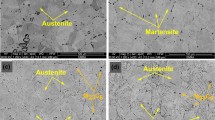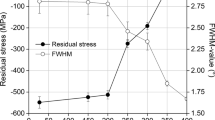Abstract
The inducement of compressive residual stress by means of deep rolling (also known as ball or roller burnishing) has been widely investigated over the last decades; however, the influence of cyclic loading on stress relaxation of rolled components has not received the same attention. Therefore, the principal aim of this work is to study the behaviour of macro- and microresidual stresses (the latter assessed in terms of the full width at half maximum, FWHM) on the surface of AISI 1060 steel specimens under rotating bending tests. For this purpose, samples with three distinct heat treatments (subcritical annealing, full annealing and hardening by quenching and tempering) were deep rolled at various combinations of rolling pressure and number of passes. The results indicate that the tensile residual stress obtained after turning shifted to compressive stress after deep rolling. The FWHM decreased after deep rolling at the lowest pressure, thus suggesting that deep rolling promoted a better distribution of the dislocations induced by previous turning; however, the further elevation of rolling pressure and number of passes caused the elevation of the FWHM. The macro- and microresidual stress values were not drastically altered after rotating bending testing with an applied stress corresponding to 50 % of the yield strength. Nevertheless, residual stress relaxation was observed with an applied stress of 80 % of the yield strength, though the FWHM did not provide evidence of microresidual stress relaxation. Finally, the analysis of the fractured cross-sections of hardened specimens indicated that the location of the crack initiation site deepens with the elevation of rolling pressure.
Similar content being viewed by others
References
Dalaei K, Karlsson B, Svensson L-E (2011) Stability of shot peening induced residual stresses and their influence on fatigue lifetime. Mater Sci Eng A 528:1008–1015
Chui P, Sun K, Sun C, Wu C, Wang H, Zhao Y (2012) Effect of surface nanocrystallization induced by fast multiple rotation rolling on mechanical properties of a low carbon steel. Mater Des 35:754–759
Schulze V (2006) Modern mechanical surface treatment. Wiley, Weinheim
Tadic B, Todorovic PM, Luzanin O, Miljanic D, Jeremic BM, Bogdanovic B, Vukelic D (2013) Using specially designed high-stiffness burnishing tool to achieve high-quality surface finish. Int J Adv Manuf Technol 67:601–611
Mohammadi F, Sedaghati R, Bonakdar A (2014) Finite element analysis and design optimization of low plasticity burnishing process. Int J Adv Manuf Technol 70:1337–1354
Löhe D, Vöhringer O (2002) Stability of residual stresses. In: Totten G, Howes M, Inoue T (eds) Handbook of residual stress and deformation of steel. ASM International, Materials Park, pp 54–69
Zhuang WZ, Halford GR (2001) Investigation of the residual stress relaxation under cyclic load. Int J Fatigue 23:S31–S37
Jhansale HR, Topper TH (1973) Engineering analysis of the inelastic stress response of a structural metal under variable cyclic strains. In: Cyclic stress–strain behaviour– analysis, experimentation, and failure prediction, ASTM STP 519, American Society for Testing and Materials, pp 246–270
Withers PJ (2007) Residual stress and its role in failure. Rep Prog Phys 70:2211–2264
Afazov SM, Becker AA, Hyde TH (2010) Effects of micro-stresses from machining and shot-peening processes on fatigue life. Int J Adv Manuf Technol 51:711–722
Denkena B, Köhler J, Breidenstein B, Mörke T (2011) Elementary studies on the inducement and relaxation of residual stress. Procedia Eng 19:88–93
Holzapfel H, Schulze V, Vöhringer O, Macherauch E (1998) Residual stress relaxation in an AISI 4140 steel due to quasistatic and cyclic loading at higher temperatures. Mater Sci Eng A 248:9–18
Löhe D, Lang KH, Vöhringer O (2002) Residual stresses and fatigue behavior. In: Totten G, Howes M, Inoue T (eds) Handbook of residual stress and deformation of steel. ASM International, Materials Park, pp 27–53
Abrão AM, Denkena B, Köhler J, Breidenstein B, Mörke T, Rodrigues PCM (2014) The influence of heat treatment and deep rolling on the mechanical properties and integrity of AISI 1060 steel. J Mater Process Technol 214:3020–3030
Abrão AM, Denkena B, Breidenstein B, Mörke T (2014) Surface and subsurface alterations induced by deep rolling of hardened AISI 1060 steel. Prod Eng Res Dev 8:551–558
Abrão AM, Denkena B, Köhler J, Breidenstein B, Mörke T (2014) The influence of deep rolling on the surface integrity of AISI 1060 high carbon steel. Procedia CIRP 13:31–36
Deutsches Institut für Normung (2009) DIN 50125 Test of metallic materials—tensile test pieces (in German). Beuth Verlag GmbH, Berlin, 14 pp
Deutsches Institut für Normung (1982) DIN 50113 Testing of metallic materials; rotating bending fatigue test (in German). Beuth Verlag GmbH, Berlin, 14 pp
Noyan IC, Cohen JB (1987) Residual stress—measurement by diffraction and interpretation. Springer, New York
Berstein G, Fuchsbauer B (1982) Festwalzen und schwingfestigkeit. Z Werkstofftech 13:103–109
Du B, Zhu W, Ma B, Li N (2004) Prolonging fatigue life of a damaged steel by annealing. Int J Fatigue 26:1017–1023
Author information
Authors and Affiliations
Corresponding author
Rights and permissions
About this article
Cite this article
Abrão, A.M., Denkena, B., Köhler, J. et al. The inducement of residual stress through deep rolling of AISI 1060 steel and its subsequent relaxation under cyclic loading. Int J Adv Manuf Technol 79, 1939–1947 (2015). https://doi.org/10.1007/s00170-015-6946-0
Received:
Accepted:
Published:
Issue Date:
DOI: https://doi.org/10.1007/s00170-015-6946-0




